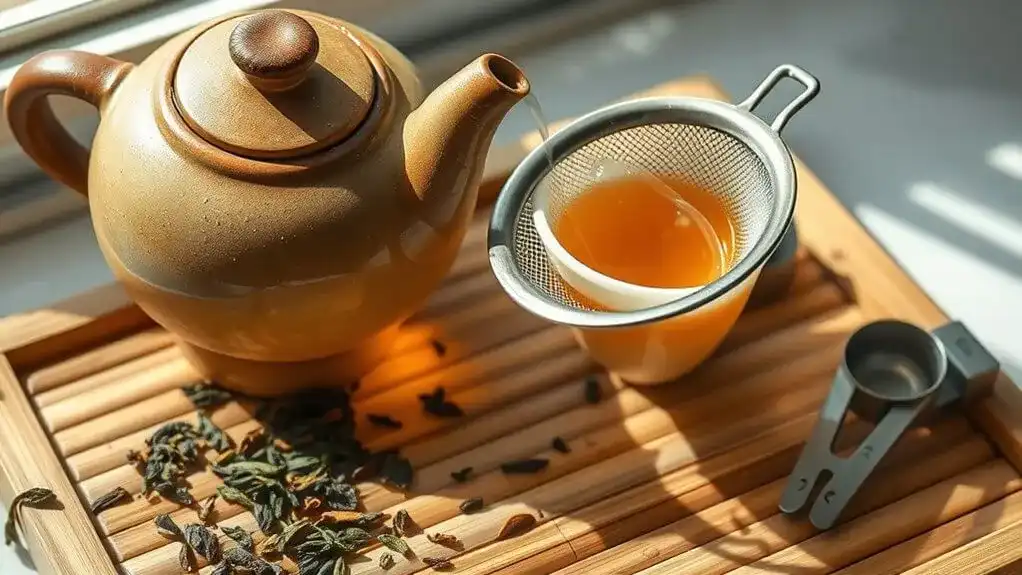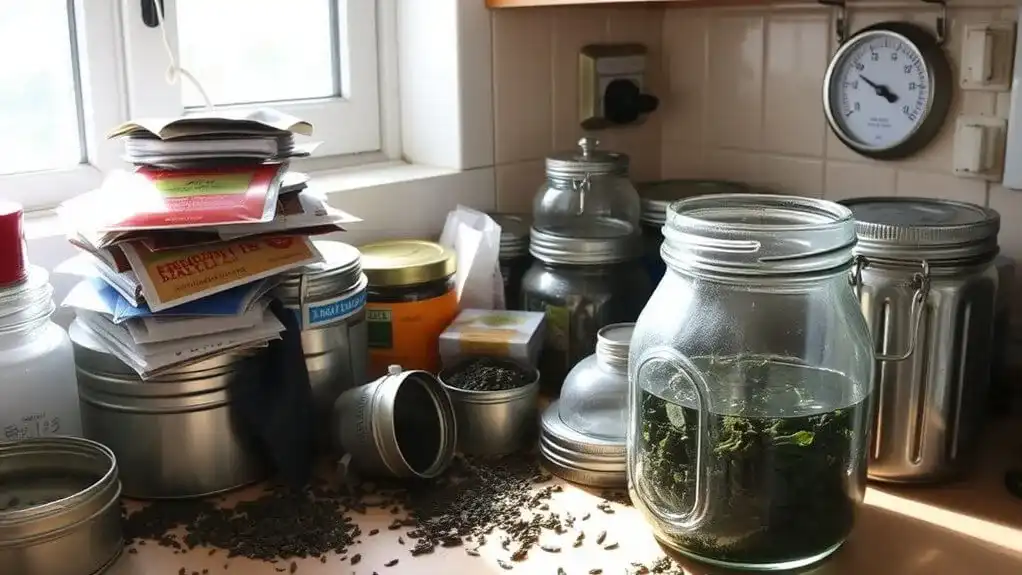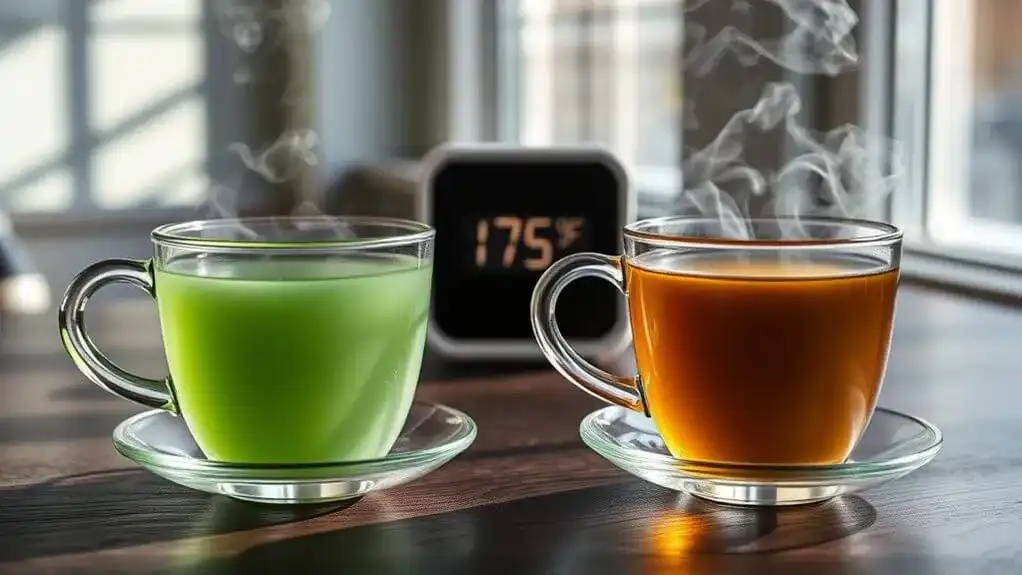Brewing the perfect cup of tea requires attention to key elements: premium whole leaves, proper equipment, and precise timing. A tea master starts with fresh, high-quality leaves and pure water at the correct temperature – 212°F for black teas and 175°F for green varieties. Steeping times vary from 1-3 minutes for delicate teas to 3-5 minutes for robust blacks. While these basics form a foundation, mastering advanced techniques will reveal tea's full potential.
Key Points
- Select whole, uniform tea leaves with vibrant colors and natural luster to ensure balanced flavor profiles and optimal brewing results.
- Use fresh, cold water with a pH below 7, avoiding repeatedly boiled water which lacks oxygen content.
- Match water temperature to tea type: 140°F for green teas, 175-180°F for oolongs, and 212°F for black teas.
- Control steeping time precisely: 1-3 minutes for green/white teas, 3-5 minutes for black teas, up to 10 minutes for herbals.
- Choose appropriate brewing vessels: smaller ones for Gongfu style with more leaves, larger ones for Western style with fewer leaves.
The Art of Selecting Premium Tea Leaves
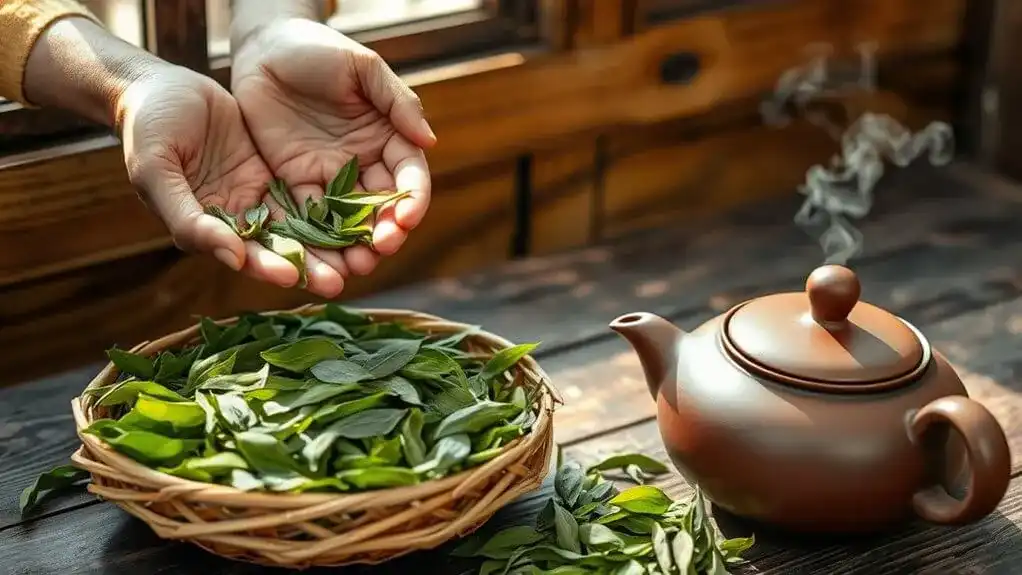
While many tea enthusiasts focus on brewing techniques, the journey to a perfect cup begins with selecting premium tea leaves. Understanding key leaf characteristics helps identify superior teas – whole, uniform leaves indicate careful processing and promise balanced flavor profiles, while broken leaves often release excessive tannins and bitter notes. For optimal results, use loose-leaf tea varieties rather than tea bags. Exploring essential tea vocabulary, such as terms like “oxidation” and “terroir,” can further enhance one’s ability to distinguish high-quality teas. Recognizing factors like aroma, appearance, and mouthfeel allows tea drinkers to refine their palate and appreciate subtle flavor nuances. By mastering these elements, enthusiasts can elevate their tea experience and unlock the true potential of each brew.
Quality leaves showcase vibrant colors and natural luster, with consistent shapes throughout the batch. They're packed in airtight containers to preserve their essential oils and distinctive aromas. Single garden teas reflect the unique character and terroir of their specific growing region. When examining tea leaves, look for specific indicators based on variety: green teas should display bright, intact leaves, while premium black teas often feature golden or light green tips. Fresh leaves will release a pleasant, characteristic scent, signaling their readiness to deliver a remarkable brewing experience. Traditional Dragon Well tea offers a distinctive nutty aroma with a sweet and mellow taste that exemplifies premium green tea characteristics.
Essential Equipment for Tea Excellence
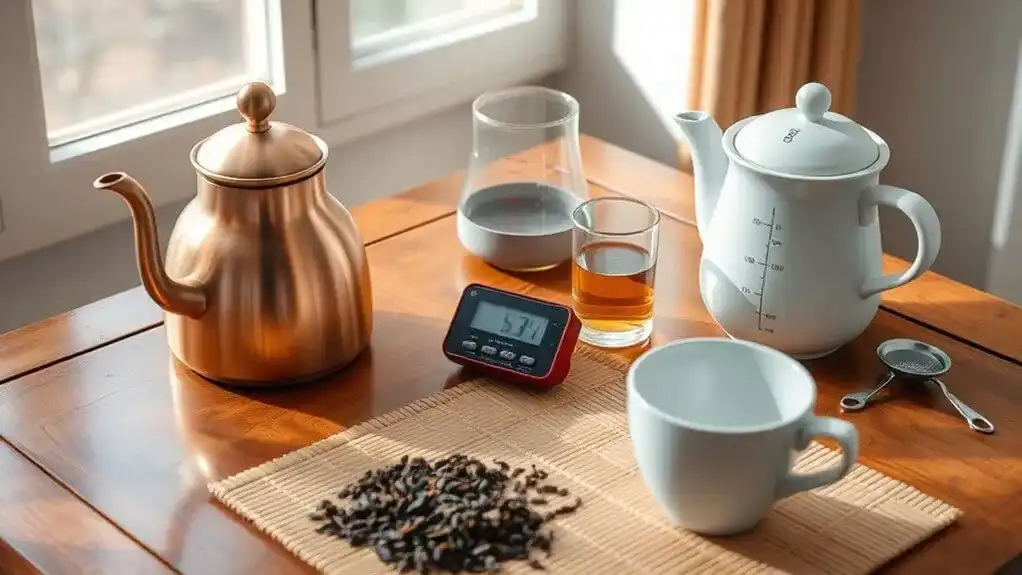
A proper arsenal of tea equipment forms the foundation of exceptional brewing. Among the essential brewing vessels, teapot types vary from glass and stoneware to clay and cast iron, each offering unique benefits for different tea varieties. Quality filtration tools, such as basket infusers and strainers, guarantee leaves can fully expand and release their flavors. Yunomi cups are preferred in Japan for their ability to cool tea quickly. Basket filters allow for easy removal of leaves after steeping to prevent over-brewing. Stainless steel teapots are particularly well-suited for daily use due to their heat retention and dishwasher-safe properties.
Temperature control plays an important role in tea excellence, making precise kettles and thermometers invaluable tools. While electric and stovetop kettles provide reliable heating, microwaves should be avoided due to uneven water temperatures. For specialized tea preparation, items like the traditional gaiwan, bamboo whisks for matcha, and a chahai for serving enhance the brewing experience. Proper storage containers round out the essential collection, helping maintain tea freshness and quality over time.
Understanding Water Temperature and Quality
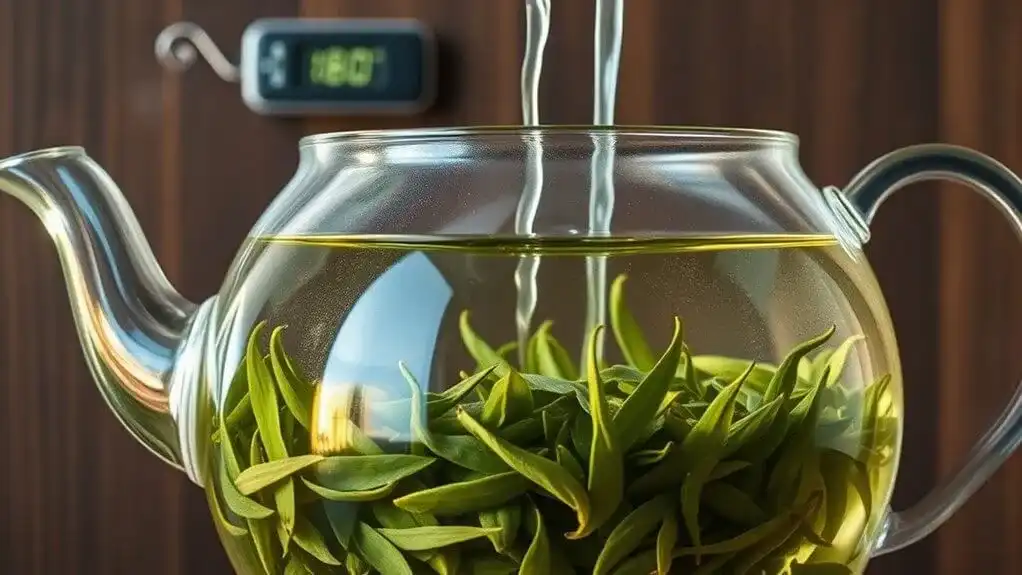
Beyond having the right equipment, mastering water temperature and quality forms the backbone of exceptional tea brewing. Each tea variety demands specific water temperatures: specialty green teas need 140°F, while black and herbal teas require boiling water at 212°F. Using incorrect temperatures can lead to bitter or weak results. Electric kettles have become increasingly popular among tea enthusiasts for their precise temperature control capabilities. A proper steeping time of 6-10 minutes for black tea ensures optimal flavor extraction without excessive tannins. Water quality plays an equally significant role. The best brewing results come from pure, odorless, and colorless water with a pH below 7. It is vital to use fresh, cold tap water or spring water, as repeatedly boiled water loses oxygen content and diminishes flavor. Tea enthusiasts can achieve precise temperature control using specialized water boilers or by letting it cool to the desired temperature. Through experimentation with these variables, they'll discover their tea's ideal brewing conditions. Transferring between vessels is an effective traditional method for cooling water to the right temperature.
Mastering the Perfect Steeping Time
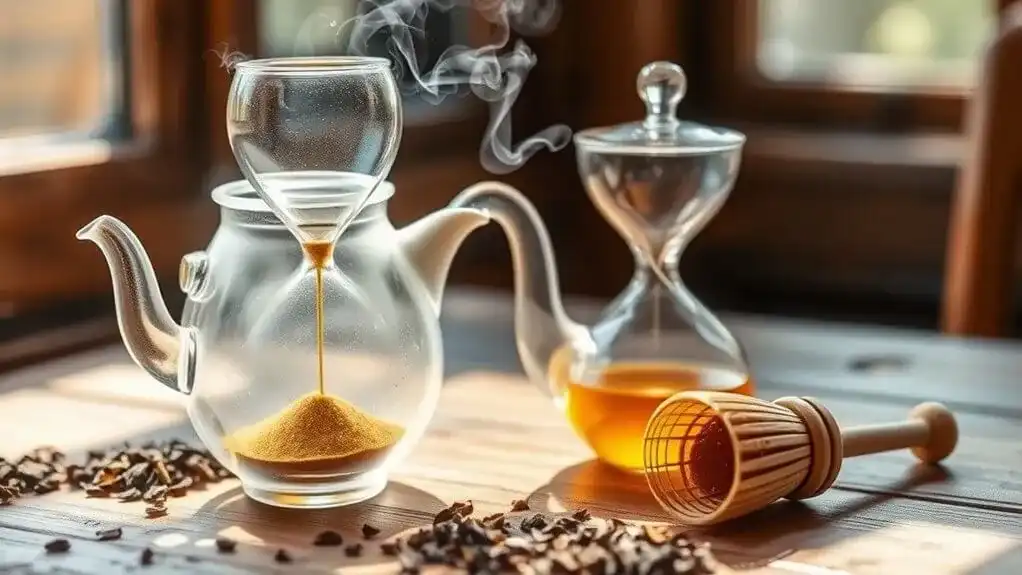
Getting the steeping time right can make or break your perfect cup of tea. The steeping duration directly impacts flavor balance, with each tea type requiring specific timing for ideal results. While black and pu-erh teas can handle 3-5 minutes of steeping, delicate white and green teas need just 1-3 minutes to prevent bitterness. Herbal teas can steep for up to 10 minutes without becoming bitter. Having a proper tea ratio helps ensure consistent results every time you brew.
Tea enthusiasts should consider several factors when determining steep times. Water temperature plays an essential role – hotter water extracts flavor more quickly, requiring shorter steeps. The amount of tea leaves used also affects steeping duration, as more leaves need less time to achieve desired strength. For best results, use a timer and keep notes on your preferences. Many teas, especially oolongs, can be re-brewed multiple times, offering different flavor profiles with each steeping. For those who prefer a gentler approach, cold brew steeping requires at least four hours or overnight in the refrigerator.
Advanced Brewing Techniques and Tips
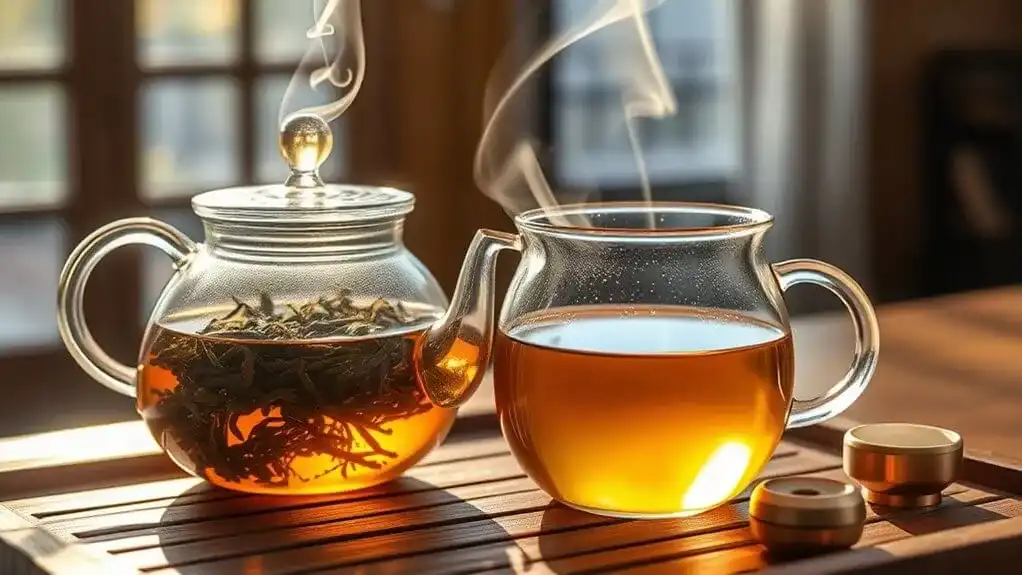
While mastering basic brewing methods is essential, advanced techniques can elevate your tea experience to new heights. The key lies in understanding the relationship between water temperature and steeping methods for different tea varieties. Black teas thrive in water between 200-212°F, while green teas prefer cooler temperatures around 175-180°F to preserve their delicate flavors. Extended steep times become necessary at lower temperatures. Herbal teas require full boiling water for optimal extraction. For maximum flavor extraction, using a tea press method allows leaves to fully expand and release their essential oils.
Leaf ratios play a significant role in achieving ideal results. Gongfu brewing, which uses more leaves in a smaller vessel, creates intense, complex flavors through multiple short infusions. In contrast, Western-style brewing employs fewer leaves in larger vessels for longer steeps. Each method offers unique advantages: Gongfu brewing reveals subtle flavor shifts, while Western brewing provides a consistent, balanced cup. Experimenting with these techniques helps tea enthusiasts discover their preferred brewing style.
Conclusion
Like a skilled conductor leading an orchestra, the master tea maker orchestrates each element to create liquid perfection. When one blends superior leaves with pristine water at precise temperatures, while honoring time-tested steeping methods, they'll reveal tea's full potential. The result isn't just a beverage—it's a symphony of flavors dancing across the palate, transforming an everyday ritual into an extraordinary sensory journey.
